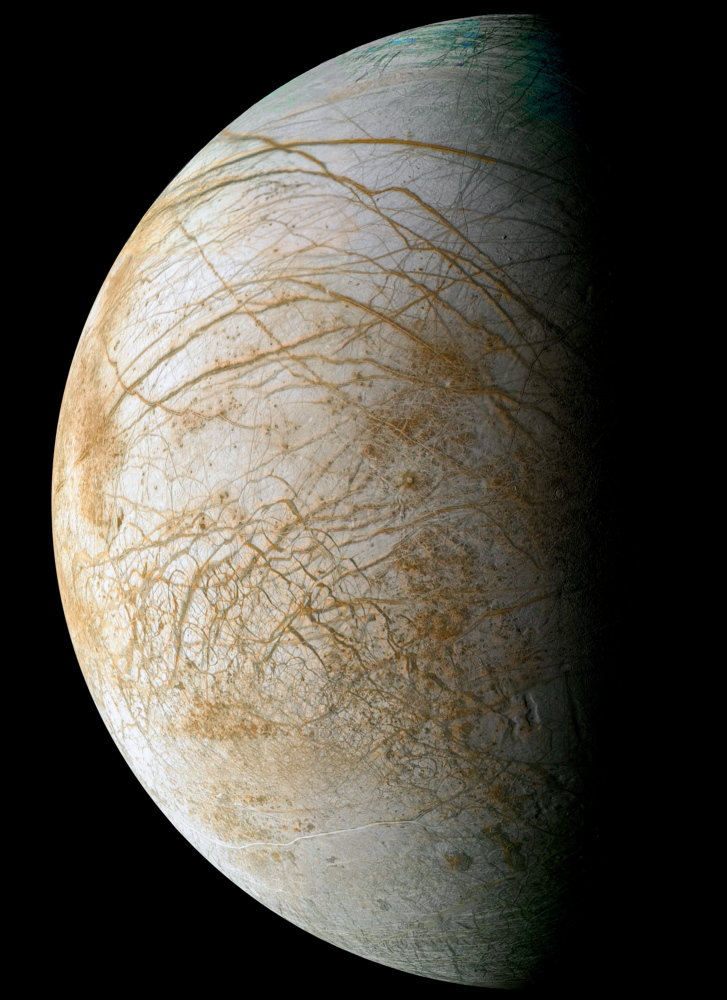About 25,000 years ago, our part of the world was covered by ice a mile and a half thick. It extended 180 miles out beyond the rock and sand we now call the coast of Maine. In the next thousand years the Earth started warming up and the ice slowly melted. By about 14,000 years ago, ocean shoreline was exposed at about the vicinity of Farmington today.
The point here is not that this winter it has seemed almost cold enough to maintain a glacier, but that underneath the ice there was not only rock, but everything we know and love today. In particular, ocean, where we all came from. The astronomers believe that hidden oceans of liquid water might not be unique to paleolithic Earth. Several other floating orbs may have internal oceans, including Pluto, of all places, and Saturn’s moon Titan, and Jupiter’s moons Callisto, Ganymede and, in particular, Europa, which is completely covered with ice.
It’s kind of unsettling to think about. Europa circles silently around and around in Jupiter’s magnetic- and gravity-ridden space. It’s white and smooth. The ridges, pits, cracks and grooves in its ice rise and descend no more than a few hundred yards, which is about the terrain you’d find if you expanded a cue ball to just less than the size of our own moon.
Europa also has a thin atmosphere of mostly oxygen, odd for a moon, or anywhere actually. It’s thought to be formed from sunlight striking water molecules and splitting them into their two atoms of hydrogen, which is light and drifts away, and oxygen, which is heavier and stays. The unusualness of this is not the gases as much as it is the water that gives rise to them: Europa’s ice shell is estimated to be 50 to 100 miles deep, and underneath that is believed to be a saltwater ocean. The Hubble space telescope recently spotted what appear to be eruptions of water vapor from the ice, corroborating the theory.
How could there be an ocean in a place whose average surface temperature is minus 260 degrees Fahrenheit? Well, the warmth that keeps the water liquid is generated through tidal heating. The whole moon is twisted and flexed by the interacting gravity fields of Jupiter (whose gravitation is so big it keeps Saturn in line) and its three other large moons. The twisting creates heat deep inside. Evidence of the heat are flows of ice on Europa’s surface, not liquid rivers but ice that emerges from inside which is warmer than the dead-cold surface.
There is a lot of scientific excitement about what that warmth might imply about Europa’s underworld. If its inner ocean is liquid, then it’s reasonable to wonder if life could have sparked and evolved in there. How anything could live in total darkness under ice 50 miles thick, no one is sure. But extremophiles — creatures living in environments fatal to the rest of us — have been found in very unlikely spots here on Earth, like in near-boiling water, in radiation that would kill a human, and in ice.
Some years ago, NASA researchers drilled a hole in the Antarctic ice sheet and stuck a video camera down there to see what was going on with the water, when a three inch long shrimplike creature muckled onto the camera. It lives there under the ice. If things can evolve so they live under Antarctic ice, then living things might be evolving inside Europa.
These are just cold, hard facts the astronomers give. Cold up to the point, anyway, where the possibility of something living inside Europa twists up your imagination and different kinds of fact-based excitement start bubbling into thoughts.
Wandering reflections on the possibilities of extraterrestrial life are fascinating, but can get kind of unsettling. Recently the eminent physicist Stephen Hawking warned that searching for intelligent extraterrestrial beings is risky because if they exist, they might not be friendly. So far, nobody thinks that any possible Europan beings are intelligent in our way of defining the word. If they exist, they’re more like those shrimpisms, or much smaller. Or maybe like the monster in the recent, detail-accurate film “Europa Report.”
But really, how do we have any clue what’s evolving under that ice? What unthinkable things right now, this exact moment, are twisting, furling and muckling in that frigid blackness?
Anyway, these are just thoughts wandering off and twisting around in the dark. We don’t know what’s under that Europa-wide glacier, waiting to be exposed.
Dana Wilde lives in Troy. His writings on the stars and planets are collected in “Nebulae: A Backyard Cosmography,” available from Booklocker.com and online book sellers. Backyard Naturalist appears the second and fourth Thursdays each month. You can contact him at naturalist@dwildepress.net.
Send questions/comments to the editors.




Success. Please wait for the page to reload. If the page does not reload within 5 seconds, please refresh the page.
Enter your email and password to access comments.
Hi, to comment on stories you must . This profile is in addition to your subscription and website login.
Already have a commenting profile? .
Invalid username/password.
Please check your email to confirm and complete your registration.
Only subscribers are eligible to post comments. Please subscribe or login first for digital access. Here’s why.
Use the form below to reset your password. When you've submitted your account email, we will send an email with a reset code.